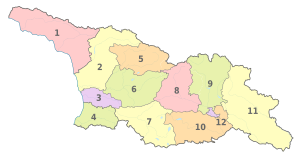User:Berdiau
Keep trying
Proposal
Colchis Wetlands and Forests
Area of Colchis wetlands and forests is c. 74 826 ha. Due to its uniqueness, Colchis wetlands ecosystems were given a status of international importance under the Ramsar Convention in 1997.
This area is one of the last remains of the landscape belt, rich in tropical and sub-tropical habitats, which existed some ten million years ago and stretched as an almost unbroken line over the vast Eurasian continent. This is the unique territory with its biodiversity, wetlands and forest ecosystems variety, high endemic, richness in relics of the tertiary period and especial objects of geological and paleontological importance.
The territory is cut by a numerous bog-type small stagnant rivers (Pichori, Kukani, Dedabera, Tkhorina, Tsia, Tsiva, Churia, Munchia, Mukhurjina, etc.). Here one can find the scenic lakes - Paleastomi, Patara Paleastomi, Imnati, Parto Tskali. The peat bogs such as Anaklia, Churia, Nabada, Imnati, Maltakva, Grigoleti and Pichori that contain contemporary and fossil unbroken peat layers are located in the coastal plain. The thickness of the peat layers in certain places exceeds 12 meters. The main mass of peat in the mentioned bogs is subsided below the sea level.
The warm, humid climate and the dense hydrographical network have, to a great extent, contributed to the rich floristical composition and the development of rather diverse vegetation. The coastal peat bogs are the home for the Boreal flora species - sphagnum mosses - Sphagnum spp.; Drozera roxundiflora, Drosera rotundifolia, Rhinchospora afla, Carex lasiocarpa, Menianthes trifoliata, etc. The plants of the alpine zone - Rhododendron flavum and Rhododendron ponticum give the bogs especial appearance. In the swamped and wetland forests, alongside the peat bogs, Alnus barbata, Pterocarya pterocarpa, Quercus imeretina, Quercus hartwissiana, etc., are found. These forests are characterised by the development of evergreen undergrowth (Hedera colchica, etc.). Aquatic plants, such as Nymphaea alba, Trapa, etc., are common in the peat bogs, lakes, swamp rivers and along them. The vegetation of coastal zone's sandy dunes is of much interest. On the substrata of this narrow stripe typical salt-loving, xerophytes and ephemeral vegetation (Hippophae rhamnoides, Paliurus spina-christi, Imperata cylindrical, Cynodon dactylon, Pancratium maritimum, Glaucum corniculatum, etc.) are developed. The uniqueness of the park's vegetation is determined by plentiness of relic and endemic species (Alnus barbata, Pterocarya pterocarpa, Quercus imeretina, Quercus hartwissiana, Trapa, etc.).
The coastal zone together with the adjacent marine area lies along one of the main routes of migration of water-fowls and waders of Africa and Eurasia. Over 194 different bird species are found within the region, including 21 species of migratory birds. A number of species, such as Black Stork (Ciconia Nigra), Crane (Grus grus), Great White Egret (Egretta alba), are on the verge of extinction and included in the Red Data Book of Georgia. The National Park together with other areas of the Kolkheti lowlands is considered the homeland of the legendary Colchis pheasant. The park swamps, swamp rivers, lakes, swamped and wetland forests provide a shelter for a number of endangered species, such as roe deer, boar, otter, Triturus vittatus, Emys orbicularis, Elaphe longisima. The marine area provides a comparatively undisturbed habitat for dolphins (Delphinus delphis, Tursiops truncates, Phocoena phocoena).
Colchis Wetlands and Forests meet criteria defined by the Ramsar Convention. The territory as a whole represents natural and unmodified environment, which should ensure future protection and dynamic development of all representative ecosystems as a complex.
Svans
Typically bilingual, they use both Georgian and their own, unwritten Svan language, which together with the Georgian, Mingrelian, and Laz languages constitute the South Caucasian or Kartvelian language family. In their opinion Svans speak one of the old Georgian language [1] which is mainly a family spoken language; while Georgian is an official administration, school, church and literary language.
According to the ECLING Project, Svan language consists of five dialects: "Upper Svan" dialects which is distributed in the Inguri valley above and below the Bal mountain), and the "Lower Svan" dialects Lashkh, Lentekhian and Cholurian along the Cxeniskali river. The main differences between the dialects and sub-dialects are observable in their sound systems, but there are also considerable divergences in morphology and syntax. Project reported the number of speakers of Svan does not exceed 30,000 people (1997 census), and which is steadily decreasing in recent times. [2]
Regions
|
| |||||||||||||||||||||||||||||||||||||||||||||||||||||||||||||


